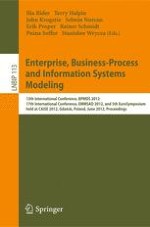This book contains the refereed proceedings of the 13th International Conference on Business Process Modeling, Development and Support (BPMDS 2012) and the 17th International Conference on Exploring Modeling Methods for Systems Analysis and Design (EMMSAD 2012), held together with the 24th International Conference on Advanced Information Systems Engineering (CAiSE 2012) in Gdańsk, Poland, in June 2012.
The 17 papers accepted for BPMDS were selected from 48 submissions and cover a wide spectrum of issues related to business process development, modeling, and support. They are grouped into sections on business process in the cloud, advanced BPM in an organizational context, similarity, variations and configuration, BPM and requirements engineering, humans and business process models, and BPM technologies using computational methods.
The 13 papers accepted for EMMSAD were chosen from 28 submissions and focus on exploring, evaluating, and enhancing current information modeling methods and methodologies. They are grouped in sections on modeling of enterprise architecture, modeling facts and rules, business process modeling, modeling of non-functional requirements, safety modeling and analysis, quality of models and modeling languages, and supporting the learning of conceptual modeling.
